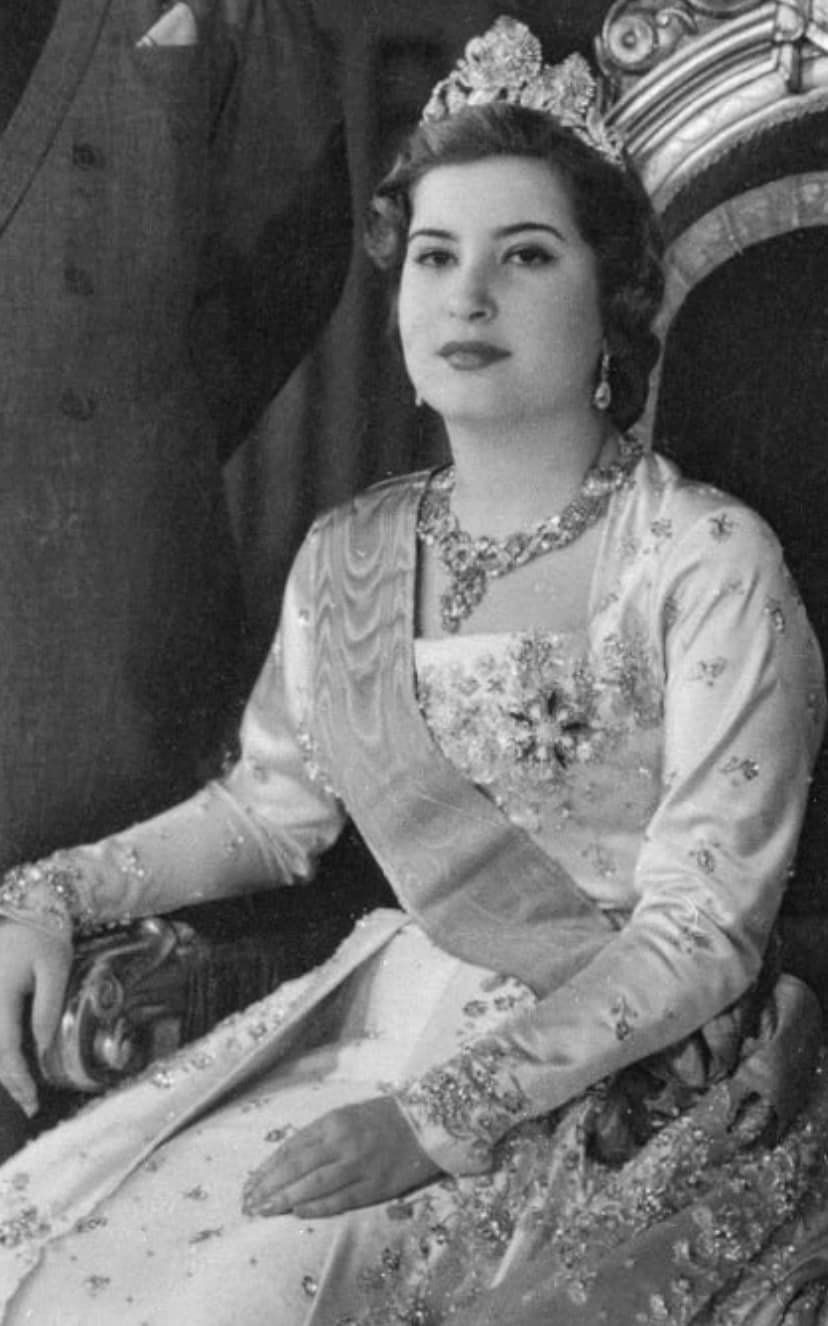The Contemporary Cleopatra
King Farouk presciently proclaimed, “Soon there will be only five Kings-the King of England, the King of Spades, the King of Clubs, the King of Hearts, the King of Diamonds.” His prophecy came to pass, at least in regard to his kingdom that made his consort the last queen of the Nile. 
The Old Testament relates that King David, from the roof of his palace, spied Bathsheba bathing. Although she was the wife of Uriah, her husband did not serve as impediment, and David took her to bed. Fast-forward a few millennia, and a similar Mideastern scenario came to pass. Sixteen-year-old Narriman (“vivacious spirit”) Sadek was the only child of Assila and Hussein Fahmy Sadek, the Secretary General of the Ministry of Communications. Narriman was the fiancée of Zaki Hachem, a Harvard-educated economist on Egypt’s United Nation’s staff; the society pages referred to their upcoming nuptials as “the marriage of the year.” The couple was shopping in a Cairo jewelry store when its owner, Ahmed Nagib Pasha, told them to return the next day when he would have the perfect ring.
King Farouk, whose name translates to “the one who distinguishes between right and wrong,” scion to the century old Egyptian throne, had gathered several “talent scouts” to find his next consort. His first had been Safinaz Zulficar, renamed Farida, (“the Peerless One,”) in accordance with the tradition that all members of the royal family have names beginning with the letter F, a tradition believed to bring good luck. The marriage ended when, after three daughters, Farouk felt his wife would never deliver a male heir. The Shah of Iran had likewise divorced Farouk’s sister, Fawzia Fuad, who had not produced a son.
The jeweler phoned the king with the news he had met the lady who satisfied his requirements: young, attractive Muslim. The following afternoon, King Farouk peered through the blinds of a window, spellbound by “a mouth that held a glint of lively humor, and eyes that danced with gentle friendliness.” He drove to the Sedek home to announce Narriman was going to become the Queen of Egypt. Despite having sent out 500 invitations, her parents cancelled the wedding, partially persuaded after Hussein received the title of Bey, (governor of a district). In a nod to winning over Narriman, Farouk lavished her with gifts of jewels and flowers that led newspapers to dub her “the Cinderella of the Nile.” Infuriated the king had usurped the woman he loved, Zaki was further incensed when imperial agents raided his apartment and confiscated Narriman’s photographs and letters. In addition, the secret police had been trailing him. In compensation, the king offered the would-be groom the position as ambassador to Russia, an opportunity Zaki refused. His final comment on the situation was, “A bad dream. I did not think such things could happen in the 20th century. Now I know better.” When the news leaked of the King’s amorous blitzkrieg, Farouk tightened his grip on the media. His rationalization was that an obscure diplomat’s happiness was less important than that of “Farouk I, King of Mist, Lord of Nubia and the Sudan, Sovereign of Kordofar and Darfur.” His sister, Faiza, simply stated, “He was not mad, just bad.”
In the role of a Pygmalion, Farouk sent Narriman to the Egyptian embassy in Rome to prepare her for her role as future queen where she lived under the assumed identity as the niece of the Egyptian ambassador. Tudors instructed her in etiquette, history, music, and four European languages. Staff monitored her weight to conform with Farouk’s directive she return to Egypt weighing no more than 110 pounds. Ironically, the king eventually topped the scales at 300 pounds, partially due to his consumption of industrial quantities of oysters and sodas. A world-syndicated memoir, (one not penned by Narriman), stated, “His shoulders fascinated me, and his arms and his powerful wrists covered with dark, virile hair… I found love such as I would never have dared to hope for.” The king’s memoir, also penned by a professional writer, waxed poetic, “Life without her would be lonely indeed…Narriman was the first human being…who really began…to understand the man behind the panoply of royalty.”
In a nod to the troubled state of the world and the fact that he had already enjoyed an opulent first wedding, King Farouk promised his second would be more low-key. Nevertheless, 2,500 people gathered in the square outside the suburban palace at Kubbeh. Missing from the number was the seventeen-year-old bride in accordance with Muslim tradition that only males be present. With the close of the formalities, canons released a 101-gun salute, and the guests enjoyed a lavish reception. At Narriman’s home, a smaller crowd kept vigil to catch a glimpse of the seventeen-year-old bride. When she emerged, accompanied by the king’s oldest sister, they departed in a bright red Rolls Royce with black fenders, followed by a motorcade of five red motorcycles, three red jeeps, two red Cadillacs, and eleven other vehicles. The procession passed under an arch that displayed a pink neon heart with the initials F and N as an estimated 1,000,000 spectators looked on. Eighteen minutes after leaving her home, Narriman entered Abdeen Palace for a reception that lasted late into the night. The bride wore a white satin gown emblazoned with 20,000 diamonds brilliants, a result of twenty seamstresses who had labored for 4,000 hours. A seven-tier wedding cake in the banquet hall towered over guests such as the Aly Khan; the king cut a piece for his bride with a small saber and presented it on a gold plate. Guests gifted the royal newlyweds extravagant gifts such as a jeweled vase from Haile Selassie and a writing set embossed with Russian gemstones from Stalin. None rivalled the Mercedes-Benz 540K that Adolf Hitler had sent Farouk for his 1938 marriage to Farida. A four-month European honeymoon began aboard the Mahroussa, the royal yacht whose crew of sixty wore identical white blazers, white jackets, and yachting caps. By night, the king lost vast sums at the baccarat table. The lavishness of their vacation erased any good will that had been generated from Narriman’s status as a commoner.
One of their main homes was the opulent 500-room Aberdeen Palace, three times the size of Buckingham Palace, with a gate fashioned in France that enclosed a fountain encircled by statues of Egyptians rulers. The predominant decorating touch was gold found on the backs of chairs, the frames of paintings, the surfaces of countless clocks.
In 1953, the thirty-one-year-old King Farouk instructed his government to announce to “both parts of the Nile Valley, north and south, and to the rest of the world the birth of Crown Prince Ahmed Fuad. The king was reported to be “deliriously happy.” In honor of his wife, the king ordered the Anglos-Swiss Hospital in Alexandria renamed the Queen Narriman Hospital.
The golden clocks began to wind down; ten days after welcoming Ahmed, there was an outbreak of rioting and mass demonstrations where the mob demonstrated their fury against its monarch. Part of their anger stemmed from Farouk’s defeat in the 1948 Arab Israeli war that led to the founding of the Jewish homeland. The king, whose philandering had not stopped with his marriage, grew even more distant from Narriman as the threat to his crown intensified. Under duress by the military officers that had surrounded the royal palaces with armed forces, Farouk abdicated. The Cabinet proclaimed the seven-month-old Crown Prince as King Fuad II. When the new rulers raided the palace, they found 1,000 men’s suits, rare stamps, coins, jewels, and watches. They also stumbled upon a huge stash of pornography, some under Farouk’s pillow. The king’s take on the smut, “They were classical artworks.”
The deposed queen now had to contemplate Farouk’s powerful, hairy wrists in exile-first on Capri, finally in a 30-room villa replete with eight servants in the Alban Hills outside Rome. Farouk and Narriman’s lives were spent in the casinos, racetracks, and European grand hotels; at the opera, Farouk accompanied the orchestra by banging his silverware. Other times they went their own ways driving his and hers Mercedes; Narriman hung out with fellow teenaged girls, while her husband stepped out with a French blonde or an Italian brunette.
No longer a vivacious spirit, no longer blinded by the bling, Narriman turned her back on her marriage, and, accompanied by her mother and Jou-Jou, her pet poodle, boarded a plane to Switzerland. Farouk, who blamed his mother-in-law for the breakdown of his marriage, retained custody of their son, as he did of his three daughters, Princess Ferial, Princess Fadia, and Princess Fawzia. To her great sorrow, Narriman was seldom allowed visitation. When Egypt became a republic, Ahmed lost his title. In Geneva, Narriman let it be known she was returning to Egypt and filing for divorce; she received no alimony. After hearing the news, Farouk visited Rome’s Club Boite Pigalle where he sat at his usual table that held a bottle of mineral water in a champagne bucket and kept a 2 a.m. rendezvous with a blonde.
In 1954, Narriman married an Alexandria surgeon, Dr. Adham al-Naqu, and had a son, Akram. The marriage floundered; in 1967, she wed another physician, Ismail Fahmi. Her final years were spent in Heliopolis, where she died from a brain hemorrhage, at seventy-one.
Despite repeated requests, Narriman only granted one interview in which the journalist was only interested in her first husband. The former queen’s response, “We have spoken so much about King Farouk. What about Narriman?” She also refused to write her memoir; had she done so, the world would have had an intimate account from the contemporary Cleopatra.


